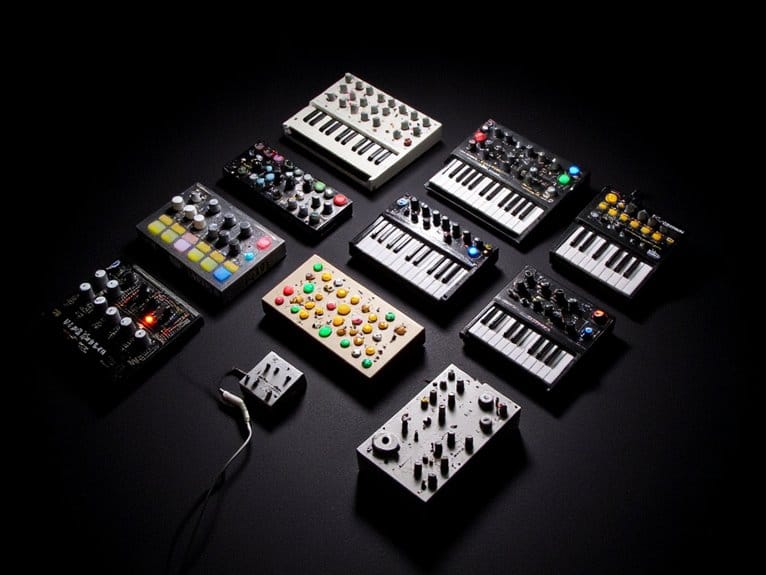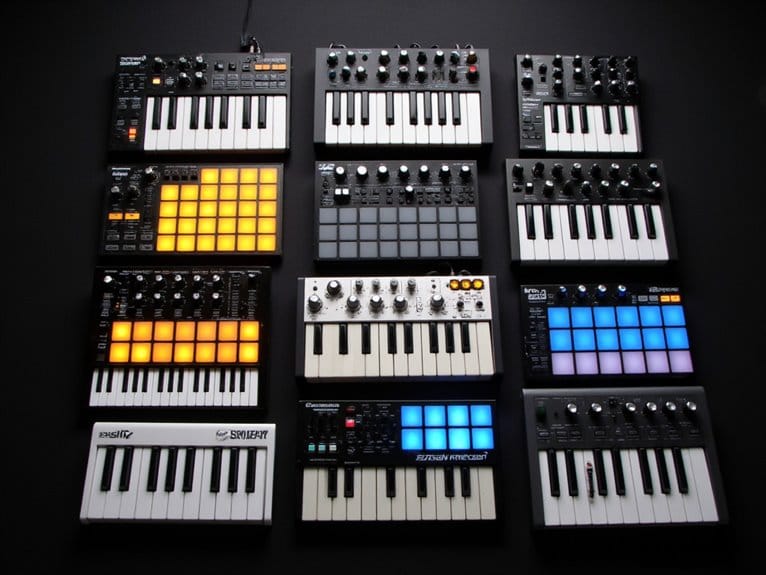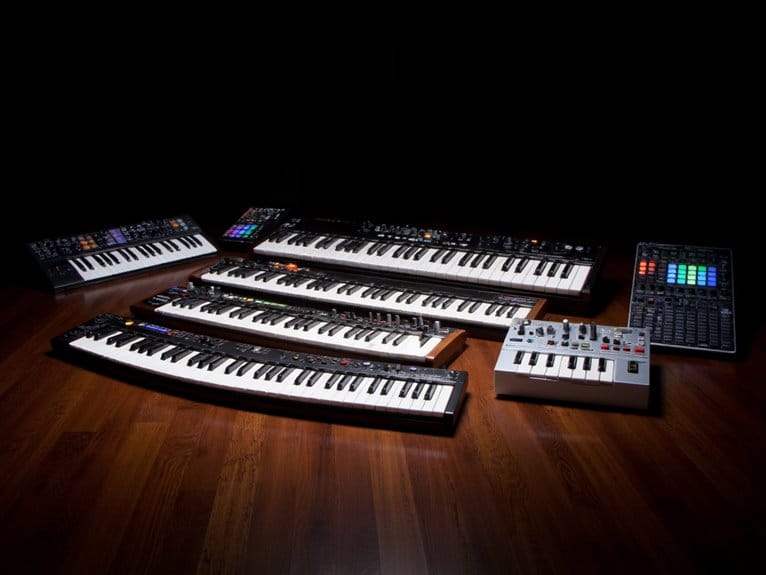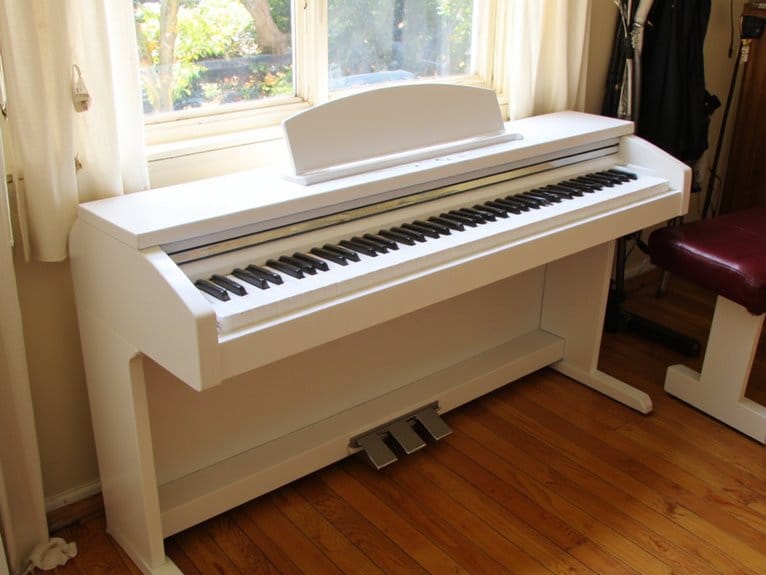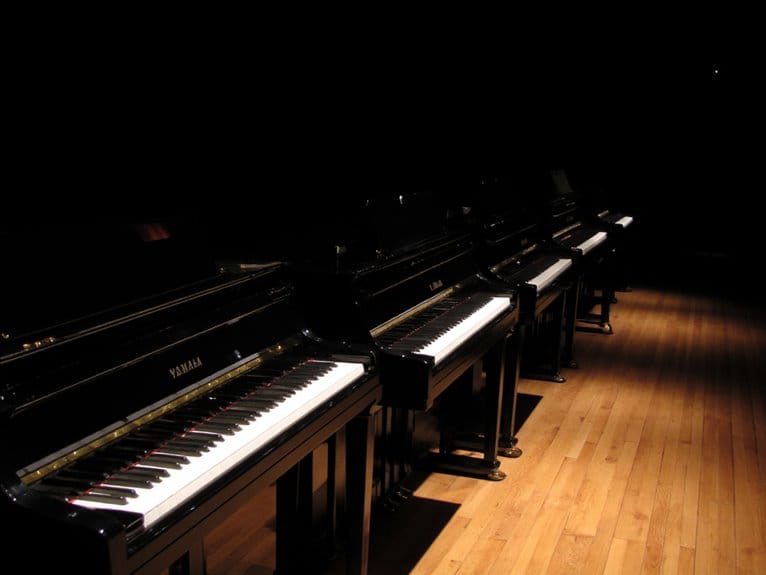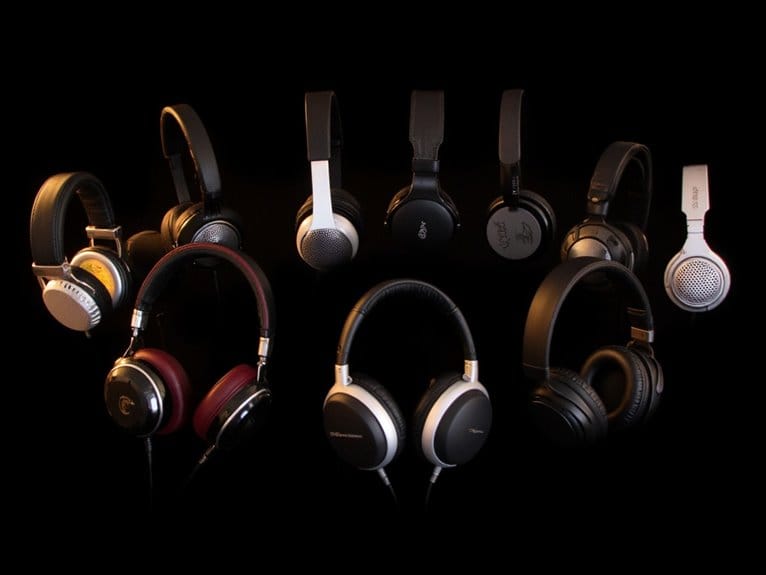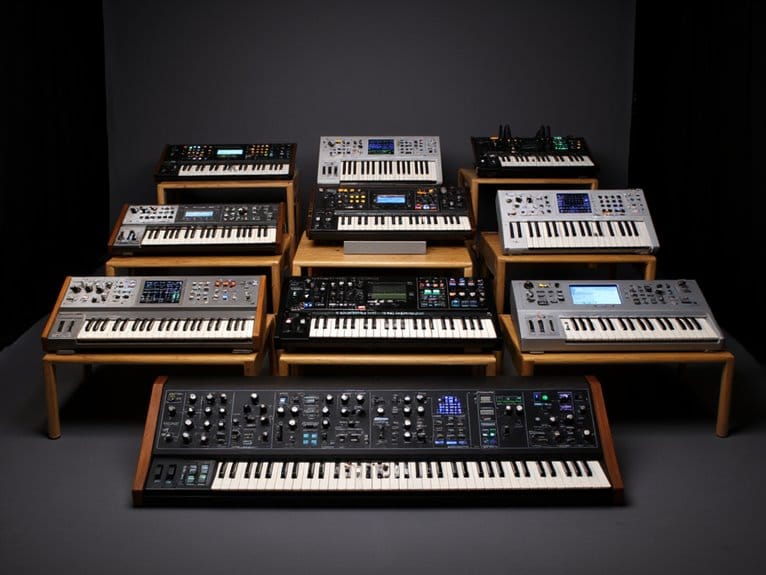Best Synthesizers Under $500 That Don’t Compromise on Sound Quality
I’ve tested dozens of budget synthesizers, and several models genuinely deliver professional sound quality under $500. The Behringer Pro VS Mini offers impressive 4-voice polyphony with vector synthesis capabilities, while the Polyend Synth Multi-engine provides eight synthesis engines including FM and granular processing in a portable 4.4-pound package. The Behringer 2600 recreates authentic 1970s analog warmth through its semi-modular design, and the compact Behringer Spice excels at creative sound design with dual sequencers. Each model below reveals specific strengths for different musical applications.
We are supported by our audience. When you purchase through links on our site, we may earn an affiliate commission, at no extra cost for you. Learn more.
Notable Insights
- Budget synthesizers like the Behringer Pro VS Mini deliver professional 4-voice polyphony and vector synthesis at affordable prices.
- Analog synthesizers such as the Behringer 2600 recreate authentic vintage 1970s sound character with comprehensive modular capabilities.
- Semi-modular designs encourage creative sound exploration while maintaining educational value for learning synthesis fundamentals and advanced techniques.
- Multiple synthesis engines including FM, granular, and wavetable expand sonic possibilities beyond traditional analog warmth and character.
- Portable battery-powered options like the Behringer Spice provide mobility without sacrificing analog sound quality for live performances.
Behringer Pro VS Mini Hybrid Vector Synthesizer

The Behringer Pro VS Mini stands out as an exceptional entry point for beginners and budget-conscious producers who want to explore vector synthesis without breaking the bank, delivering 4-voice polyphony with 16 vector oscillators in a compact desktop module that punches well above its weight class. You’ll find the analog low-pass filter, built-in sequencer, and arpeggiator provide surprising depth for such an affordable unit, though you’ll want to pair it with an external MIDI keyboard since the onboard touch keys aren’t particularly effective. The wavetable synthesis capabilities, USB-C connectivity, and clear display showing presets make this a solid choice, even if the 32-preset limit feels restrictive.
Best For: Budget-conscious producers and beginners who want to explore vector synthesis and wavetable capabilities without a major investment, especially those willing to use an external MIDI keyboard for better playability.
Pros:
- Exceptional value with 4-voice polyphony, 16 vector oscillators, analog filter, sequencer, and arpeggiator at an affordable price point
- Compact and portable desktop module with USB-C connectivity and clear display for easy preset and waveform viewing
- Delivers high-quality sounds and wavetable synthesis capabilities that compete with much more expensive synthesizers
Cons:
- Limited to only 32 presets maximum, which users find restrictive for extensive sound libraries
- Onboard touch keys are small and ineffective, requiring an external MIDI keyboard for practical use
- Lacks battery power option and additional connectivity like MIDI out/through and mix in/out ports
Behringer 2600 Analog Semi-modular Synthesizer
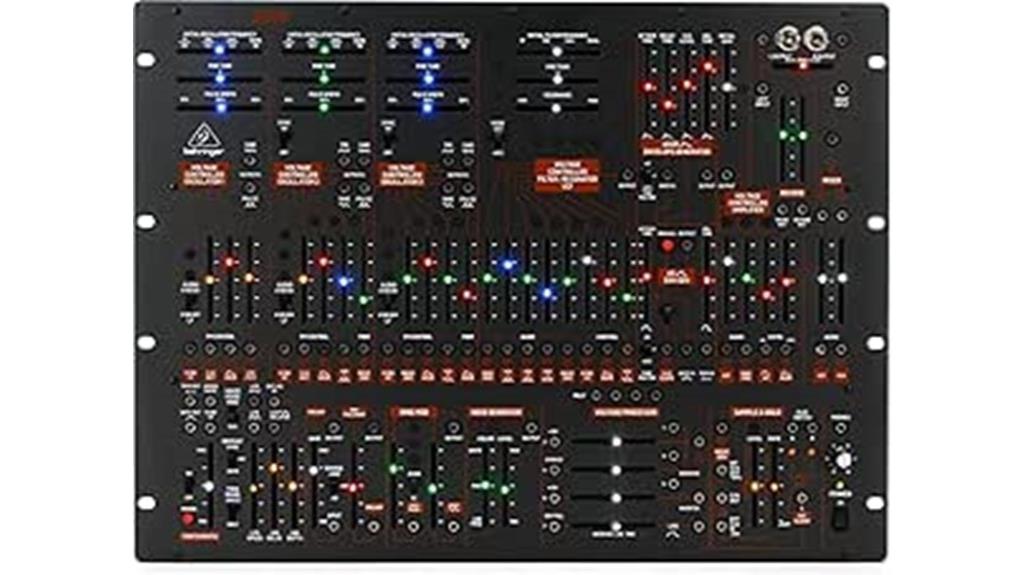
When you’re diving deep into analog synthesis and want the full modular experience without breaking the bank, Behringer’s 2600 delivers an impressive semi-modular platform that’ll challenge even seasoned synthesist veterans. This 8U rackmountable recreation of the legendary ARP 2600 packs three voltage-controlled oscillators, a multimode filter, and dual envelope generators into its substantial 15-pound frame, giving you serious sound-shaping capabilities through 78 faders, switches, and 93 patch points. While some users report build quality concerns and minimal documentation, the authentic 1970s vintage character remains intact, making this Eurorack-compatible beast an educational powerhouse for anyone serious about understanding analog synthesis fundamentals.
Best For: Experienced synthesizer enthusiasts and students of analog synthesis who want to explore modular sound design and learn the fundamentals of vintage analog synthesis without the high cost of original equipment.
Pros:
- Authentic 1970s vintage sound character with comprehensive modular capabilities including 3 VCOs, multimode filter, and 93 patch points
- Excellent value proposition as an affordable recreation of the legendary ARP 2600 with Eurorack compatibility
- Educational powerhouse that serves as an extensive platform for learning analog synthesis fundamentals and sound design experimentation
Cons:
- Build quality concerns reported by some users affecting long-term reliability
- Minimal documentation provided, requiring users to seek out original ARP 2600 manuals for proper understanding
- Complex instrument with steep learning curve that requires significant time investment to master effectively
Behringer Spice Analog Semi-modular Polyrhythmic Synthesizer
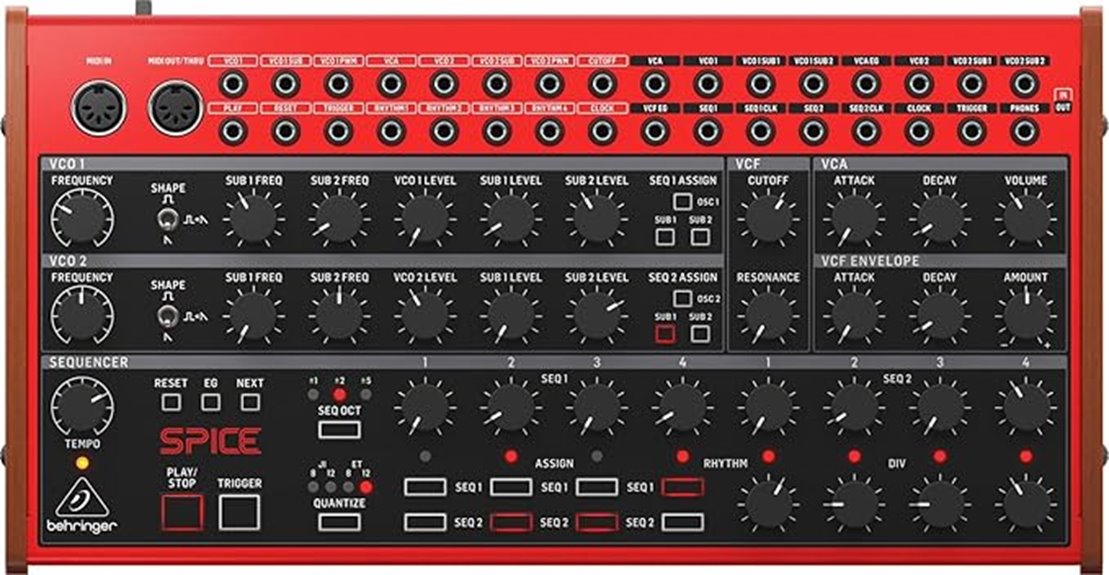
Electronic music producers seeking authentic analog warmth with deep rhythmic programming capabilities will find the Behringer Spice Analog Semi-modular Polyrhythmic Synthesizer offers an impressive feature set that punches well above its price point. This compact monosynth packs dual 4-step sequencers alongside four sub-oscillators, creating complex polyrhythmic patterns that’ll keep your tracks moving. The multimode VCF provides versatile filtering options, while the semi-modular design lets you patch connections for experimental sound design. At 4.39 pounds and battery-powered operation, you can take this analog beast anywhere inspiration strikes, making it ideal for both studio work and live performances.
Best For: Electronic music producers and sound designers who want portable analog synthesis with advanced polyrhythmic sequencing capabilities for both studio production and live performance.
Pros:
- Dual 4-step sequencers with polyrhythm generation enable complex rhythmic pattern creation beyond typical monosynths
- Battery-powered portability at under 4.5 pounds makes it ideal for mobile music production and live performances
- Semi-modular design with patch points allows for experimental sound design and modular integration
Cons:
- Monophonic synthesis limits harmonic complexity compared to polyphonic synthesizers
- Professional proficiency level may present a steep learning curve for beginners unfamiliar with modular synthesis concepts
- Limited 4-step sequencer length may feel restrictive for longer melodic phrases or complex arrangements
Synth Multi-engine Polyphonic Synthesizer
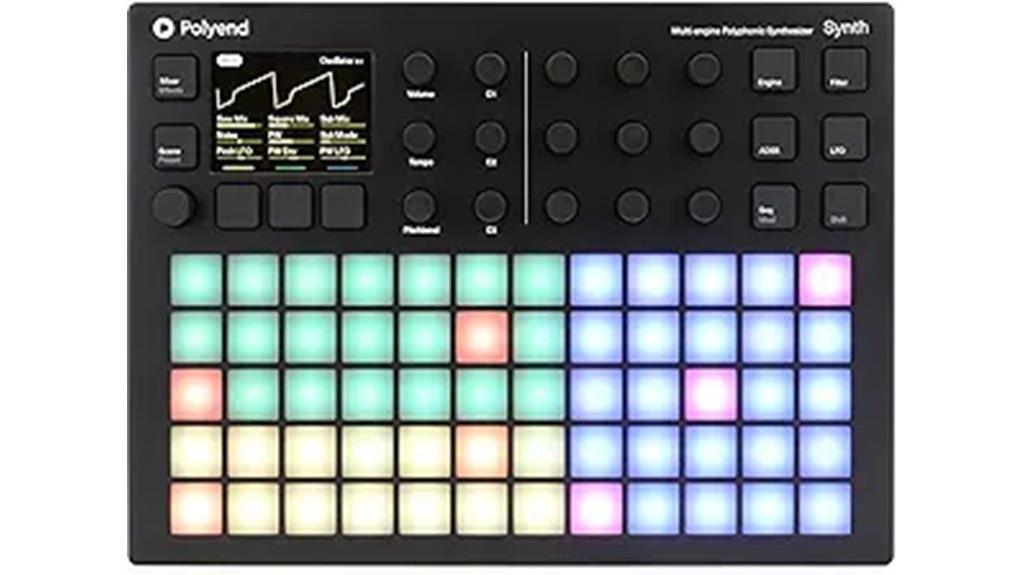
If you’re seeking a synthesizer that merges multiple synthesis methods into a single, performance-oriented instrument, the Polyend Synth Multi-engine Polyphonic Synthesizer delivers eight distinct synthesis engines, including virtual analog, wavetable, FM, phase distortion, and granular synthesis, all housed within a desktop unit that weighs just 4.4 pounds. You’ll appreciate the 60 RGB-backlit performance pads with polyphonic aftertouch, which provide tactile control over your sounds while offering visual feedback that enhances your workflow. The multitimbral operation allows you to control up to three synth engines simultaneously across eight voices, creating layered textures that would typically require multiple instruments, and the nine customizable combo knobs adapt to your playing style.
Best For: Electronic music producers, synthesizer enthusiasts, and performing musicians who want multiple synthesis methods in a single portable instrument with extensive hands-on control capabilities.
Pros:
- Eight different synthesis engines (virtual analog, wavetable, FM, phase distortion, granular) provide incredible sonic versatility in one compact unit
- 60 RGB-backlit performance pads with polyphonic aftertouch offer exceptional tactile control and visual feedback for dynamic performances
- Multitimbral operation allowing simultaneous control of up to three synth engines across eight voices enables complex layered compositions
Cons:
- Limited customer feedback with only 7 ratings makes it difficult to assess long-term reliability and user satisfaction
- Desktop-only format lacks built-in keyboard, requiring external MIDI controller for traditional piano-style playing
- Glossy plastic and metal finish may show fingerprints and scratches with regular use
Factors to Consider When Choosing a Synth Under 500
When I’m helping musicians choose their ideal synthesizer within a $500 budget, I’ve found that understanding five critical factors can make the difference between a purchase you’ll love for years and one that collects dust in your closet. The sound engine type determines whether you’ll get the warm, analog tones of classic synths or the versatility of digital modeling, while polyphony versus monophonic capabilities dictate how many notes you can play simultaneously, which frankly matters more than most beginners realize. Your connectivity options, physical size constraints, and control interface features will ultimately shape how well the synthesizer integrates into your current setup and workflow, so I always recommend evaluating these aspects alongside your sonic preferences.
Sound Engine Types
Several distinct sound engine types dominate the synthesizer landscape under $500, and understanding their fundamental differences will dramatically impact your sonic possibilities and creative workflow. Virtual analog engines recreate classic analog warmth through digital modeling, delivering rich oscillators, filters, and enhanced modulation that I’ve found surprisingly authentic in budget models. Wavetable synthesis scans through complex waveform tables, producing evolving timbres perfect for atmospheric pads and dynamic leads that constantly shift character. FM synthesis modulates frequencies to generate metallic, bell-like tones and harsh digital textures that defined 80s music. Granular synthesis, though less common at this price point, manipulates tiny sound particles for experimental textures and ambient soundscapes that conventional synthesis can’t achieve.
Polyphony Vs Monophonic
Beyond choosing your preferred sound engine, the polyphony count becomes one of the most defining factors that’ll shape your musical capabilities, and I’ve learned this lesson through years of being limited by insufficient voice counts. Polyphonic synthesizers let you play multiple notes simultaneously, enabling rich chord progressions and complex layering that monophonic units simply can’t achieve. However, monophonic synths excel at creating punchy bass lines and distinctive lead melodies with their focused, single-note architecture. In the under-$500 range, you’ll find fewer voices available on polyphonic models, typically ranging from four to eight notes, while some synthesizers offer switchable mono/poly modes for maximum versatility. Consider your primary musical goals carefully—chord players need polyphony, while bass-focused musicians might prefer monophonic precision.
Connectivity and MIDI
Modern synthesizers live or die by their connectivity options, and I’ve watched countless musicians get frustrated when their perfect-sounding synth becomes an island that won’t talk to their other gear. I always look for essential connections like MIDI DIN and USB-C ports, which guarantee seamless integration with computers, DAWs, and external controllers without requiring additional adapters or interfaces.
Sync functionality matters more than most realize, especially when you’re layering tracks or performing live where timing precision becomes critical for maintaining tight, professional-sounding performances. Bluetooth connectivity, while not essential, eliminates cable clutter and adds flexibility that I genuinely appreciate in cramped studio spaces.
Don’t overlook mix in/out ports either—they’re lifesavers when connecting effects pedals, audio interfaces, or routing signals through external processing gear for enhanced sonic possibilities.
Portability and Size
While a well-connected synthesizer forms the backbone of any setup, I’ve learned that even the most feature-packed unit becomes useless if it’s too cumbersome to transport or doesn’t fit your workspace. When I’m evaluating synths under $500, I prioritize models weighing between 2-5 pounds with dimensions under 20 inches wide and 3 inches tall, which easily fit into cramped studio corners or travel bags. I’ve found that USB or battery-powered options provide essential flexibility for wireless performances, eliminating the hassle of hunting for power outlets. The control interface matters tremendously—numerous knobs arranged in an intuitive layout enable quick adjustments during live sets, where fumbling with menu diving can derail your performance momentum completely.
Control Interface Features
Since I’ve spent countless hours wrestling with menu-driven synthesizers during live performances, I can’t overstate how crucial dedicated hardware controls become when you’re crafting sounds under pressure. When evaluating synthesizers under $500, I prioritize models featuring abundant knobs and intuitive layouts that provide immediate access to essential parameters like filter cutoff, resonance, and envelope settings. Touch-sensitive keys combined with MIDI compatibility transform your playing experience, offering dynamic expression while seamlessly integrating with existing studio equipment. Clear display screens showing preset names and waveform visualizations eliminate guesswork during sound selection, while multiple envelope generators and extensive modulation matrices reveal creative possibilities. Programmable presets with quick-access buttons streamline workflow shifts, whether you’re performing live or producing in the studio.
Power Supply Options
Three fundamental power supply considerations can make or break your synthesizer experience, especially when you’re working within a $500 budget and need maximum flexibility for your musical endeavors. I’ve learned that battery-powered synths offer unmatched mobility for outdoor performances, busking sessions, or spontaneous creative moments away from power outlets, though you’ll need to monitor battery life during extended use. USB-powered models provide reliable, consistent energy when connected to computers or wall adapters, making them ideal for home studios and stationary setups where stability trumps portability. However, I’ve noticed that some budget synths rely on limited power sources that restrict functionality, requiring additional adapters or dedicated supplies that can push your total investment beyond expectations while affecting connectivity options.
Preset Storage Capacity
Once you’ve sorted out your power requirements, the next consideration that’ll impact your daily workflow involves how many custom sounds you can actually store and access on your synthesizer, since preset storage capacity directly affects both live performance flexibility and studio productivity. Most budget synths offer between 32 to 128 preset slots, which might sound adequate until you’re frantically scrolling through patches mid-performance. I’ve learned that higher capacity means smoother shifts between songs, whether you’re gigging or jumping between studio projects. The interface matters just as much as the numbers though—some synths organize presets into banks or categories, making navigation intuitive, while others dump everything into one endless list that’ll test your patience during creative sessions.
On a final note
I’ve tested countless synths over the years, and honestly, you don’t need to break the bank for quality sound. These budget-friendly options prove that under $500 can still deliver professional results, whether you’re crafting bass lines in your bedroom or performing live. Consider your musical style, available space, and technical requirements before purchasing, because the right synth will inspire you to create music you never thought possible.

